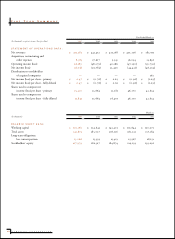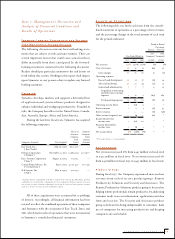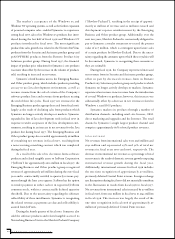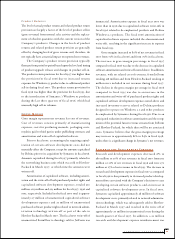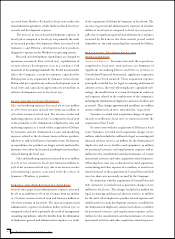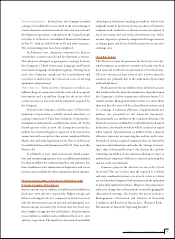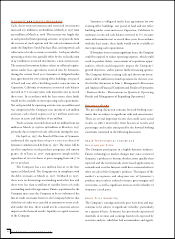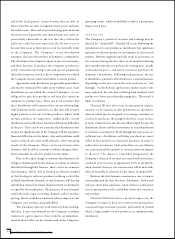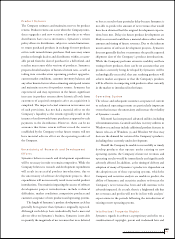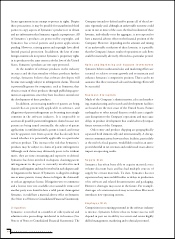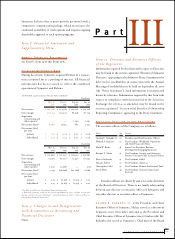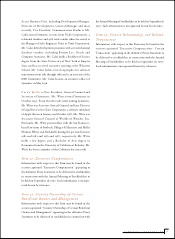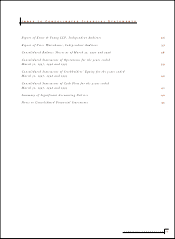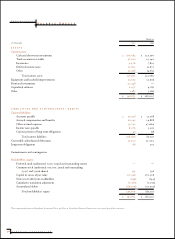Symantec 1997 Annual Report Download - page 30
Download and view the complete annual report
Please find page 30 of the 1997 Symantec annual report below. You can navigate through the pages in the report by either clicking on the pages listed below, or by using the keyword search tool below to find specific information within the annual report.
license agreements in an attempt to protect its rights. Despite
these precautions, it may be possible for unauthorized third
parties to copy aspects of Symantec’s products or to obtain
and use information that Symantec regards as proprietary. All
of Symantec’s products are protected by copyright, and
Symantec has several patents and patent applications
pending. However, existing patent and copyright laws afford
limited practical protection. In addition, the laws of some
foreign countries do not protect Symantec’s proprietary rights
in its products to the same extent as do the laws of the United
States. Symantec’s products are not copy protected.
As the number of software products in the industry
increases and the functionality of these products further
overlap, Symantec believes that software developers will
become increasingly subject to infringement claims. This risk
is potentially greater for companies, such as Symantec, that
obtain certain of their products through publishing agree-
ments or acquisitions, since they have less direct control over
the development of those products.
In addition, an increasing number of patents are being
issued that are potentially applicable to software, and
allegations of patent infringement are becoming increasingly
common in the software industry. It is impossible to
ascertain all possible patent infringement claims because new
patents are being issued continually, the subject of patent
applications is confidential until a patent is issued, and it may
not be apparent even from a patent that has already been
issued whether it is potentially applicable to a particular
software product. This increases the risk that Symantec’s
products may be subject to claims of patent infringement.
Although such claims may ultimately prove to be without
merit, they are time consuming and expensive to defend.
Symantec has been involved in disputes claiming patent
infringement in the past, is currently involved in such
disputes and litigation and may be involved in such disputes and/
or litigation in the future. If Symantec is alleged to infringe
one or more patents, it may choose to litigate the claim and/
or seek an appropriate license. If litigation were to commence
and a license were not available on reasonable terms or if
another party were found to have a valid patent claim against
Symantec, it could have a material adverse effect on Symantec
(See Note 11 of Notes to Consolidated Financial Statements).
Litigation
Symantec is involved in a number of other judicial and
administrative proceedings incidental to its business (See
Note 11 of Notes to Consolidated Financial Statements). The
Company intends to defend and/or pursue all of these law-
suits vigorously and, although an unfavorable outcome could
occur in one or more of the cases, the final resolution of these
lawsuits, individually or in the aggregate, is not expected to
have a material adverse effect on the financial position of the
Company. However, depending on the amount and timing
of an unfavorable resolution of these lawsuits, it is possible
that the Company’s future results of operations or cash flows
could be materially adversely effected in a particular period.
Sales and Marketing and Support Investments
Symantec believes substantial sales and marketing efforts are
essential to achieve revenue growth and to maintain and
enhance Symantec’s competitive position. There can be no
assurance that these increased sales and marketing efforts will
be successful.
Business Disruption
Much of the Company’s administration, sales and market-
ing, manufacturing and research and development facilities
are located on the west coast of the United States. Future
earthquakes or other natural disasters could cause a signifi-
cant disruption to the Company’s operations and may cause
delays in product development that could adversely impact
future revenues of the Company.
Order entry and product shipping are geographically
separated both domestically and internationally. A disrup-
tion in communications between these facilities, particularly
at the end of a fiscal quarter, would likely result in an unex-
pected shortfall in net revenues and could result in an adverse
impact on operating results.
Supply Risk
Symantec has often been able to acquire materials on a
volume-discount basis and has had multiple sources of
supply for certain materials. To date, Symantec has not
experienced any material difficulties or delays in production
of its software and related documentation and packaging.
However, shortages may occur in the future. For example,
shortages of certain materials may occur when Microsoft
introduces new operating systems.
Employee Risk
Competition in recruiting personnel in the software industry
is intense. Symantec believes that its future success will
depend in part on its ability to recruit and retain highly
skilled management, marketing and technical personnel.
28 SYMANTEC CORPORATION


